UNTANGLING BINARIES: WHERE CANADA SITS IN THE “21st CENTURY DEBATE”
There has been significant attention paid to 21st century learning over the past decade, but what exactly constitutes 21st century literacy in Canada? There is no “one-size fits-all” answer to this question; however, there are some broad learning, thinking, and interactional patterns that seem fundamental to the phrase that has been bandied about. As researchers who have been involved in different 21st century projects over the years, we set out to examine what counts as 21st century literacy across the provinces in Canada and, in this article, we provide the findings of our audit. This audit includes a content analysis of the provincial / territorial curricula or standards documents that inform 21st century literacy pedagogies. Ultimately, the aim of this article is to offer fodder for future discussion on how policy, practice, and 21st century literacy learning coalesce.
Untangling binaries: Technology enthusiasts vs. innovative knowledge makers
We will begin with a discussion of some of the issues that undergird the topic of 21st century literacy before we turn to Canadian perspectives. As Burnett and Merchant (2015) recently noted, even though there is abundant technology in contemporary classrooms, curricular and assessment implementation is lagging in favor of traditional literacies. To begin with, there has been a tendency in literature and media on anything 21st century to turn to “technology determinism” to explain 21st notions of literacy learning. Technology is the end in itself rather than a means to different ways of understanding texts (McLuhan, 1964; Postman, 1993; Street, 1984; Williams, 1958/1990). As Street (1984) maintains, “technology is…not a neutral ‘thing’ arising out of disinterested scientific inquiry” (p. 65), but rather technologies carry with them ideological processes and different ways of thinking that are mobilized in a wide range of ways by different people. In other words, putting tablets and interactive whiteboards in classrooms is not enough to make classrooms current in the 21st century. In everyday life, people use different technologies to fulfill tasks that pertain to communicating, thinking, composing, reading, playing and a host of other practices and processes. By analyzing one of these actions, communicating, a researcher can focus on either the device or tool and how it is used to communicate, or, a researcher can focus on how ideas get communicated through device or tool. This clear-cut separation (i.e., technology enthusiast vs. innovative knowledge makers) diminishes the complexities of both arguments, but for the purposes of this article and our audit of provincial stances on both sides of the continuum, we offer both arguments. A technology enthusiast tends to focus on digital worlds and converged texts (Jenkins, 2006) to make meaning and communicate. Technology-driven individuals think and engage through the hybridity and multimodal capacities of virtual worlds. An innovative meaning-maker, on the other hand, thrives on DIY practices and problem-solving with materials and media. Makers (Halverson & Sheridan, 2014; Peppler & Bender, 2013) use digital worlds as well as physical, material worlds to make and to create multimodal compositions. As well, we disclose our particular bias which focuses on the thinking that takes place as a helpful way of viewing technology.
21st century literacy: The case of Canada
In Canada, education is governed provincially and territorially, not nationally. The mandate for all Canadian provincial and territorial educational jurisdictions is to ensure equitable access to education for all students, with each province and territory having evolved policies and approaches to literacy education that respond to its particular needs (Government of Canada, 2015). Accordingly, each of the 10 provinces and three territories has developed curricula or standards documents that describe the learning outcomes that students should attain within a given grade or year of education. These curricula or standards reflect each province’s policies, context, and resources. This article is a pan-Canadian review and analysis of 10 of the curriculum standards documents for reference to 21st century learning skills, with a specific focus on 21st century literacy learning.
The Council of Ministers of Education, Canada (CMEC, 2013a) issued a press release stating that literacies for the 21st century are multiple (e.g., text literacy, number literacy, visual literacy, digital literacy), dynamic, as well as “essential for full participation in the social and economic life of the modern world. Citizens need to be able to understand and engage with multiple technologies along with mastering the foundational skills of reading, writing, and mathematics” (para. 1-2). This press release is consistent with the National Council of Teachers of English (NCTE, 2013) statement that “technology has increased the intensity and complexity of literate environments such that the 21st century demands that a literate person possess a wide range of abilities and competencies, many literacies” (para. 1). NCTE (2013) adds that among the abilities and competencies that literacy learners in the 21st century need to have are: proficiency and fluency with technology while they solve problems collaboratively and strengthen independent thought; ability to manage, analyze, and synthesize and information in addition to designing and sharing information; and, competencies to create, critique, analyze, and evaluate multimedia texts. Very recently, Canada’s Centre for Digital and Media Literacy (Hoechsmann & DeWaard, 2015) further defined “digital literacy as the skills and ability to use digital tools and applications; the capacity to critically understand digital media tools and content; and the knowledge and expertise to create and communicate with digital technology” (p. 4). To be a literate in the 21st century is to possess ubiquitous 21st century learning skills. Given the fact that there is no policy or position statement on 21st century literacy skills in Canada, we called on general policies related to 21st century learning skills.
Shifting mindsets through a pan-Canadian framework
Recently, in Canada, a few publications have been disseminated as white papers and position statements by task forces that delineate 21st century learning skills and put out a call to attend to how students acquire 21st century learning skills. Two of the most often referred to are: Future Tense: Adapting Canadian Education Systems for the 21st Century (Action Canada Task Force, 2013) and Shifting Minds: A 21st Century Vision of Public Education for Canada (Canadians for 21st Century Learning & Innovation, 2012). The former illuminates the need for Canada to have a “cohesive national strategy with respect to 21st century learning” (p. 3) and the latter offers a vision, guidelines, and competencies for 21st century learning that are referenced by several Canadian provinces and territories. In the context of this article, the former report substantiates our rationale and the latter report provides our analytical framework.
In Future Tense: Adapting Canadian Education Systems for the 21st Century, the Action Canada Task Force (2013) defines 21st century learning skills as competencies such as: “Critical Thinking; Problem Solving; Communication and Collaboration; Computer and Digital Literacy; Creativity, Character, and Innovation” (p. 5). In response to the challenges posed by a dynamically shifting society, students need 21st century learning skills in addition to content knowledge, specific skills, expertise, and literacies. The Action Canada Task Force (2013) created a report summarizing how a sample of provincial ministries of education have implemented policies and practices that include 21st century learning models. Findings from this report are not surprising, but quite salient. First, it is encouraging to note that the report articulates that active facilitation of 21st century learning is supported in learning environments using ICT technology where teachers have active professional learning. However, given the divergent nature of provincial and territorial educational jurisdictions, there are a wide range of practices related to 21st century learning. To begin to conceptualize a national strategy, there should first be a pan-Canadian review of curricula or standards — this article attempts to get this discussion flowing and to push the debate further, beyond a focus on technology to think more about the ideological practices that are part and parcel of technology.
The vision articulated in Shifting Minds: A 21st Century Vision of Public Education for Canada is “to witness an accelerated pace of 21st competencies, instructional practices, and digital resources and services being integrated into Canada’s learning systems” (Canadians for 21st Century Learning & Innovation, 2012, p. 5). With the student at the core of the discussion, this vision is founded on principles and learning outcomes that align with skills (i.e., Literacy, Numeracy, Science) and seven 21st century competencies. The Canadians for 21st Century Learning & Innovation (2012) document acknowledges that this vision must be interpreted given local identities, priorities, and practices and that change requires flexible implementation models. Figure 1 is an excerpt of the proposed vision and learning framework:
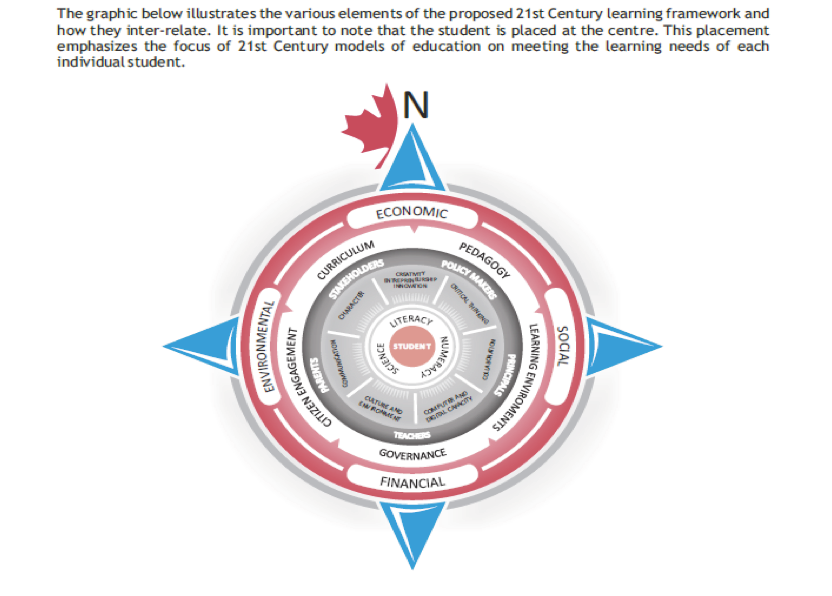
Figure 1. Vision for 21st century learning in Canada (Source: Canadians for 21st Century Learning & Innovation, 2012, p. 16)
In the middle concentric circle, surrounding “Literacy, Numeracy and Science” skills are seven competencies that 21st century learners should possess: creativity, innovation and entrepreneurship; critical thinking; collaboration; communication; character; culture and ethical citizenship; and computer and digital technologies. Appendix A is an overview of these seven competencies. These seven competencies are similar to those identified as essential competencies by the Organisation for Economic Co-operation and Development (OECD), UNESCO, and Partnership for 21st Century in the United States (among others) (Canadians for 21st Century Learning & Innovation, 2014). This source is a credible reference as an analytical structure for the current paper given its rigour compared to existing 21st century learning frameworks such as OECD (2009) and Canadian provinces (PEI; Alberta; BC), as well as its endorsement by Industry Canada, National Research Council, Canadian Council on Learning (CCL), and Council of Ministers of Education (Canadians for 21st Century Learning & Innovation, n.d.).
In Appendix A, the phrases that are in bold are those that are of particular interest for the review provided in the present paper as they reflect the definitions of literacies for the 21st century (CMEC, 2013a; NCTE, 2013) and digital literacy (Hoechsmann & DeWaard, 2015). For example, the fourth competency, “Communication,” includes the phrase, “The ability to access, analyze, integrate and manage large volumes of information.” This phrase embodies the principles in the definitions of 21st century and digital literacies. It is to be noted that five out of the seven competencies are consistent with definitions of 21st century and digital literacies.
Next, this paper analyzes whether these five competencies (creativity, innovation and entrepreneurship; critical thinking; collaboration; communication; and computer and digital technologies) are reflected in the curricular learning outcomes of the English Language Arts standards documents for Canada’s provinces and territories. It is worth noting that the present analysis is distinct from that in the Action Canada Task Force (2013) report, which looked at four competencies within provincial / territorial education strategies and vision statements. Herein, we examined the curriculum standards documents that teachers use to devise their literacy programming and lessons. Accordingly, the research question posed is: How are the competencies of the 21st century learner reflected in the learning outcomes within the English language arts curriculum standards documents for the majority of the Canadian provinces and territories?
METHOD
Given that the research question is aimed at an investigation of texts, this study was a documentary analysis of English language arts curricula or standards documents. Documentary analysis employs texts as the data source in the research process (Bowen, 2009). Specific data analysis procedures are dedicated to documentary analysis. Herein, manifest summative content analysis was used to examine text from English language arts curriculum documents for the occurrence of pre-identified words and phrases in the learning outcome statements (Mayring, 2000). Pre-identified words and phrases (verbatim from the document) were based on the analytical framework: the competencies of 21st century learners (Canadians for 21st Century Learning & Innovation, 2012). Each of the learning outcomes in the documents was a unit of analysis (Weber, 1990) that was compared to words and phrases in the analytical framework. The outcomes of this type of content analysis are frequency counts that profile the data.
Sample
The sample of provinces and territories targeted for this analysis was dictated by their performance on the most recent, 2012 Programme for International Student Assessment (PISA; OECD, 2013). This international assessment of the reading, mathematics and science literacies of 15 year olds is administered every three years by the OECD. Recently, the OECD commissioned a report (Schleicher, 2015) that recognizes that contemporary students require skills to carry them beyond what as 21st century learners. This report underscores the role that 21st century reading includes texts that are print-based and digital; as a result, for the first time, the PISA (2012) tested students in both text formats (CMEC, 2013b). The digital text assessment required students to access, interpret, and evaluate information on-line. For Canada, student performance is summarized nationally as well as by province. These data are used by provincial stakeholders to inform their decisions related to educational assessment and curricula (CMEC, 2013b). For the purposes of sampling for the current study, these provincial data were also accessed for the PISA (2012) to use as a baseline for student performance on a digital text assessment.
Students from the provinces of Nova Scotia, Quebec, Ontario, Alberta, and British Columbia performed above the OECD average and better than or as well as the Canadian average (Quebec, Ontario, Alberta, and British Columbia) in print-based text reading. For digital text, almost all of the Canadian provinces scored above the OECD average, while Nova Scotia, Ontario, and Alberta and British Columbia performed at or above the Canadian average. As a means to bracket the sample, the provinces chosen for the analysis in the current paper were based on these PISA (2012) results for print-based and digital texts. The curricula documents from these provinces were of interest given the fact that their students’ performance the PISA (2012) assessment were above the Canadian average; specifically, Nunavut, Manitoba and Saskatchewan were not included based on their performance in relation to the Canadian average.
Data collection
Further, the sample of Quebec, Ontario, Alberta, British Columbia and Nova Scotia snowballed as the latter three provinces have curricular affiliations with other provinces / territories. In Canada, the four Atlantic Provinces (Nova Scotia, New Brunswick, P.E.I., Newfoundland and Labrador) use the same English language arts curriculum, the Yukon Territory uses the same standards as British Columbia and, the Northwest Territories uses Alberta’s standards. Accordingly, our audit began with a search for the most current curricula or standards documents for the English language arts in the ten Canadian provinces / territories in the sample: Alberta (used also by NWT), Atlantic Canada (includes Nova Scotia, New Brunswick, P.E.I., Newfoundland and Labrador), British Columbia (used also by Yukon), Ontario, and Quebec. These curriculum documents articulate the provinces’ agendas for their espoused language arts program including learning outcomes or objectives to be accomplished at each grade level. It should be noted that we have adopted the term “learning outcomes” in this paper, however, the Canadian provinces refer to these by different labels, e.g., “general outcomes” in Alberta (Alberta Learning, 2000); “expectations” in Ontario (Ontario Ministry of Education, 2006). Also, provinces delineate their curriculum documents in different grade ranges (e.g., “Kindergarten-Grade 6, Grade 7-9, and Grade 10-12” in the Atlantic Provinces (Media Smarts, n.d.-a, n.d.-b, n.d.-c); “Kindergarten-Grade 7 and Grade 8-12” in British Columbia (2006). All curriculum documents were publically accessed through each respective province’s ministry or department of education website. Appendix B provides a list of these relevant curriculum documents along with a description and access information (see table note regarding updates to British Columbia’s curriculum).
Data analysis
Recall that Appendix A provides a summary of the seven competencies of 21st century learners (Canadians for 21st Century Learning & Innovation, 2012) that informed our analytical framework. The 11 underlined phrases are consistent with the definitions of 21st century and digital literacies (CMEC, 2013a; Hoechsmann & DeWaard, 2015; NCTE, 2013). As previously disclosed, as researchers, we focused on the thinking and knowledge-making that is communicated through technology. Accordingly, the underlined phrases in Appendix A were distilled into the following themes that reflect learning outcomes which position the student learner as actively processing, thinking, creating, and communicating with technology:
- 1. Processing large volumes of information for:
- a. critical thinking (acquire, process, interpret, rationalize and critically analyze)
- b. communicating (access, analyze, integrate and manage)
- 2. Using digital resources, variety of media and technology to:
- a. access information
- b. critically interpret and evaluate ideas
- c. communicate
- d. create knowledge
- e. create solutions
- 3. Using social media to:
- a. communicate
- b. learn
- 4. Developing 21st century competencies in the context of core subjects
These themes were then used to code the learning outcomes in the provincial English language arts curriculum standards documents. In this way, each of the learning outcomes was a unit of analysis that was coded (Weber, 1990). As illustration, Theme 2d (“Using digital resources, variety of media and technology to create knowledge”) was coded for the English Language Arts (K-9) (Alberta Learning, 2000) curriculum with:
General Outcome 2: Students will listen, speak, read, write, view and represent to comprehend and respond personally and critically to oral, print and other media texts.
2.4 Create original text. (p. 4)
and also in the English Language Arts (Senior High) (Alberta Learning, 2003) curriculum with:
General Outcome 4: Students will listen, speak, read, write, view and represent to create oral, print, visual and multimedia texts, and enhance the clarity and artistry of communication.
4.1 Develop and present a variety of print and non-print texts
4.1.3 Develop content. (p. 13)
Each of the above learning outcomes (2.4 and 4.1.3) was tallied once in the frequency count for Theme 2d. The coding process was done independently and then inter-rater reliability (Cohen’s Kappa) was calculated (κ > 0.80) for these categorical data. Additionally, all of the results were cross-validated between the two researchers for the purpose of triangulation and to establish credibility (Guba & Lincoln, 1982). Frequency tabulations were calculated for all the themes by province and these basic descriptive statistics are presented below as a series of figures. Some themes had several learning outcomes represented; other themes had none.
TAKING STOCK: RESULTS OF OUR AUDIT
The following results are derived after coding the English language arts learning outcomes for each of the provinces using the analytical framework of the competencies of 21st century learners. First, is an overview of the learning outcomes, then coverage by province and by themes. The results are displayed as a plot graph and bar graphs. Abbreviations have been used: AB (Alberta including NWT); AT (Atlantic Provinces of Nova Scotia, New Brunswick, P.E.I., Newfoundland and Labrador); BC (British Columbia including Yukon); ON (Ontario); PC (Quebec).
Overview of the learning outcomes
We begin with a broad summary of the proportion of the provinces’ English language arts learning outcomes that reflect the definition of 21st century and digital literacies. Figure 2 includes a series of bar graphs displaying the total number of English language arts learning outcomes and the portion that address 21st century and digital literacies. This figure depicts the disproportionate number of learning outcomes when comparing the provinces and the low relative proportion of 21st century and digital literacies learning outcomes to the total learning outcomes.
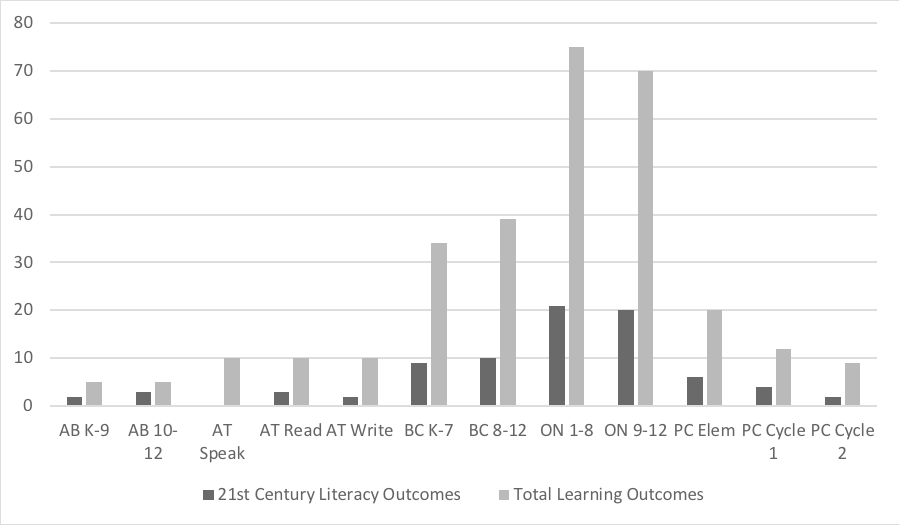
Figure 2. Total English language arts learning outcomes and the portion that address 21st century and digital literacies
For the English Language Arts (K-9) (Alberta Learning, 2000), there are 2 (out of 5) general outcomes and for English Language Arts (Senior High) (Alberta Learning, 2003) there are 3 (out of 5) general outcomes for Grades 10-12 that reflect the definition of 21st century and digital literacies. The four Atlantic provinces use the Atlantic Provinces Education Foundation Framework for English Language Arts (Media Smarts, n.d.-a, n.d.-b, n.d.-c) with 3 broad outcomes (speaking and listening; reading and viewing; writing and other ways of representing) each with 1-4 general outcomes. The general outcomes that cover 21st century and digital literacies are covered: 0 (out of 10) speaking and listening; 3 (out of 10) reading and viewing and 2 (out of 10) writing and other ways of representing. In British Columbia, in oral language, reading and viewing, writing and representing for the English Language Arts K-7 (British Columbia, 2006), there are 9 (out of 34) prescribed learning outcomes. In the English Language Arts 8-12 (British Columbia, 2007), there are 10 (out of 39) prescribed learning outcomes that reflect the 21st century and digital literacies. For Ontario’s strands (oral communication, reading, writing, media literacy) in Language Arts (Gr. 1-8) (Ontario Ministry of Education, 2006) 21 (out of 75) expectations and in English (Grades, 9, 10, 11, 12) (Ontario Ministry of Education, 2007), 20 (out of 70) expectations that are reflective of 21st century and digital literacies. The province of Quebec’s Elementary English Language Arts (n.d.) has 6 (out of 20) learning outcomes (“Key Features”), the Secondary English Language Arts (cycle 1, Quebec Education Program [QEP], n.d.-a) has 4 (out of 12) learning outcomes, and the Secondary English Language Arts (QEP, n.d.-b) for cycle 2 has 2 (out of 9) learning outcomes that reflect phrases in the definitions of 21st century and digital literacies.
Audit of the themes
Each of the learning outcomes was treated as a unit of analysis and coded using the themes outlined in the data analysis above. Table 1 is an aggregated summary of these themes (refer to data analysis above) for each of the provincial curriculum standards documents.
TABLE 1. Summary of themes by provincial curriculum documents
|
Province / Document |
Theme |
|||||||||
|
1a. |
1b. |
2a. |
2b. |
2c. |
2d. |
2e. |
3a. |
3b. |
4. |
|
|
PC Cycle 2 |
• |
• |
|
|
|
|
|
|
|
|
|
PC Cycle 1 |
• |
|
|
• |
• |
|
• |
|
|
|
|
PC Elem |
• |
• |
|
• |
• |
|
|
|
|
|
|
ON 9-12 |
• |
• |
• |
• |
• |
|
|
|
|
|
|
ON 1-8 |
• |
• |
• |
• |
• |
• |
|
|
|
|
|
BC 8-12 |
• |
• |
|
• |
• |
• |
|
|
|
|
|
BC K-7 |
• |
• |
|
• |
• |
• |
|
|
|
|
|
AT Write |
|
|
|
• |
• |
• |
|
|
|
|
|
AT Read |
• |
• |
• |
• |
|
|
|
|
|
|
|
AT Speak |
|
|
|
|
|
|
|
|
|
|
|
AB 10-12 |
• |
• |
• |
• |
• |
• |
|
|
|
|
|
AB K-9 |
• |
• |
• |
• |
• |
• |
• |
|
|
|
All provinces thoroughly address Themes 1a. and 1b. (“Processing large volumes of information for: critical thinking; communicating”) and to a great extent Themes 2b and 2c (“Using digital resources, variety of media and technology to: critically interpret and evaluate ideas; communicate”). There is some coverage for “Using digital resources, variety of media and technology to: access information; create knowledge; create solutions.” Most notable are the lack of learning outcomes that address Themes 3a and 3b, “Using social media to: communicate; learn” and Theme 4, “Developing 21st century competencies in the context of core subjects.”
Figures 3 to 9 depict the frequency or breadth of coverage of the learning outcomes in each provincial curriculum standards document for the themes of 21st century and digital literacies. Variances are noted among the provinces but also within a given province with respect to how comprehensively these outcomes are cited. Following these seven figures is a summary of the conclusions drawn from these findings.
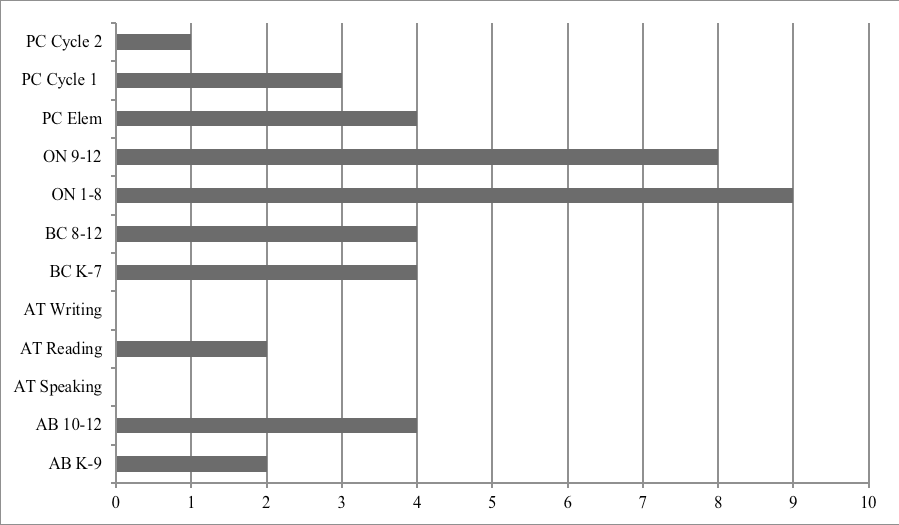
Figure 3. Theme 1a: Processing large volumes of information for critical thinking. Frequency of learning outcomes in each provincial curriculum standards document
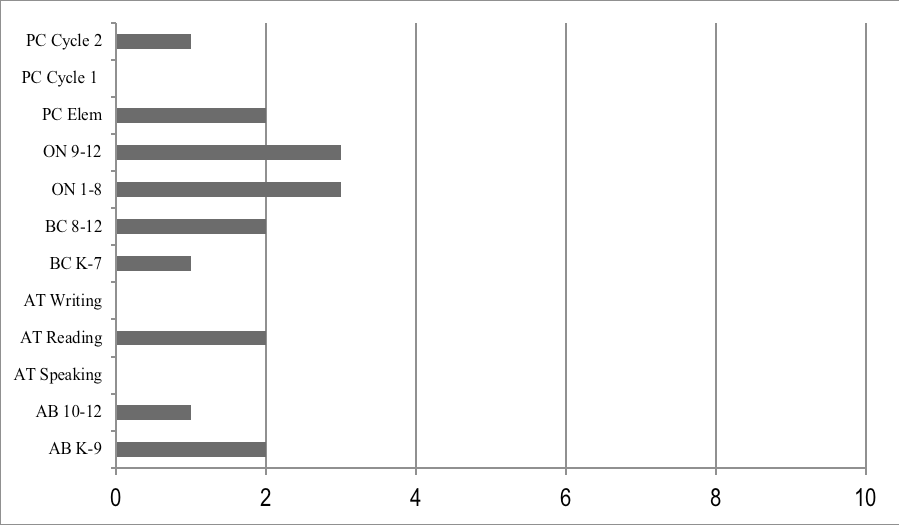
Figure 4. Theme 1b: Processing large volumes of information for communicating. Frequency of learning outcomes in each provincial curriculum standards document.
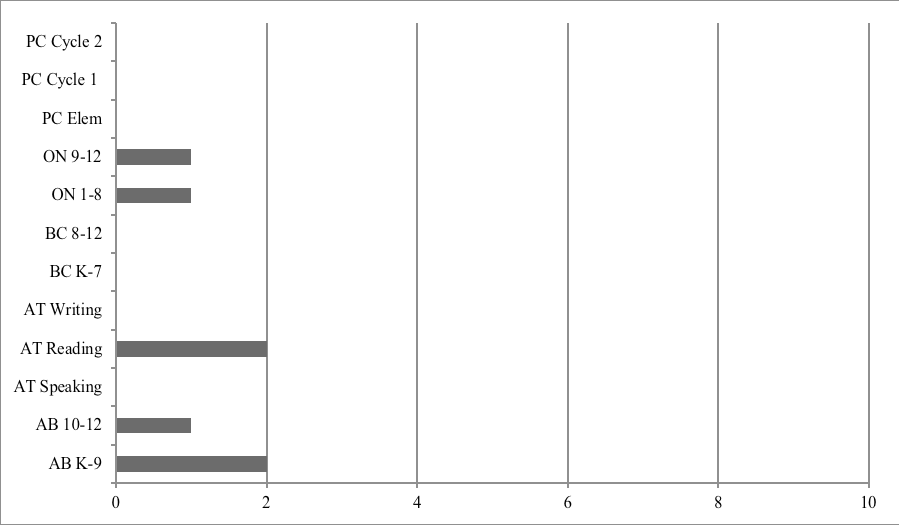
Figure 5. Theme 2a: Using digital resources, media and technology to access information. Frequency of learning outcomes in each provincial curriculum standards document.
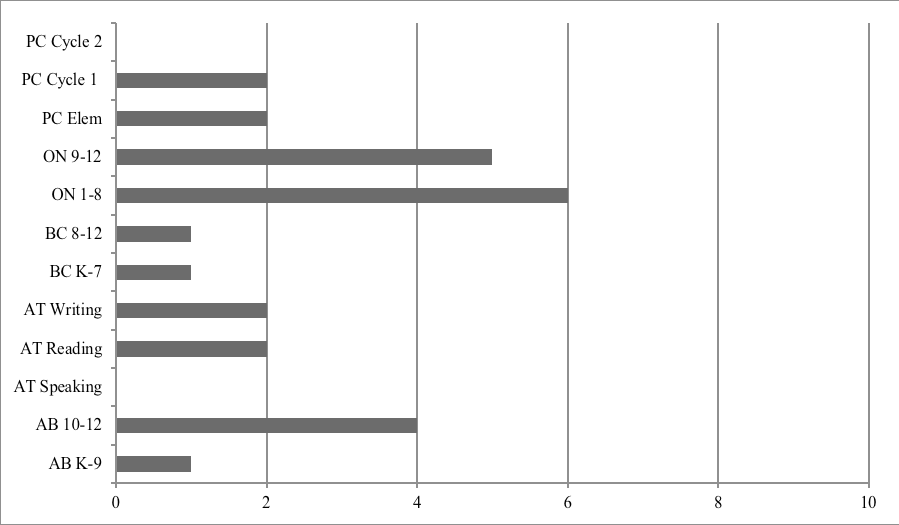
Figure 6. Theme 2b: Using digital resources, media and technology to critically interpret and evaluate ideas. Frequency of learning outcomes in each provincial curriculum standards document.
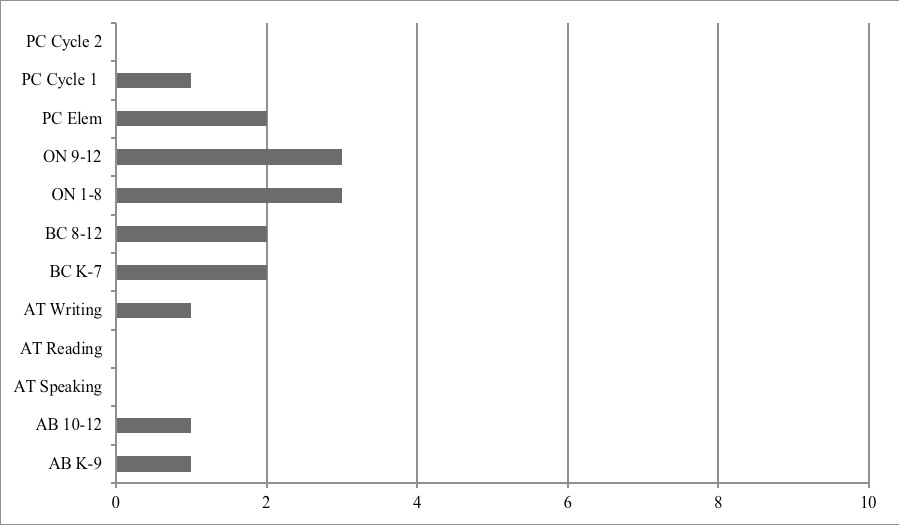
Figure 7. Theme 2c: Using digital resources, media and technology to communicate. Frequency of learning outcomes in each provincial curriculum standards document.
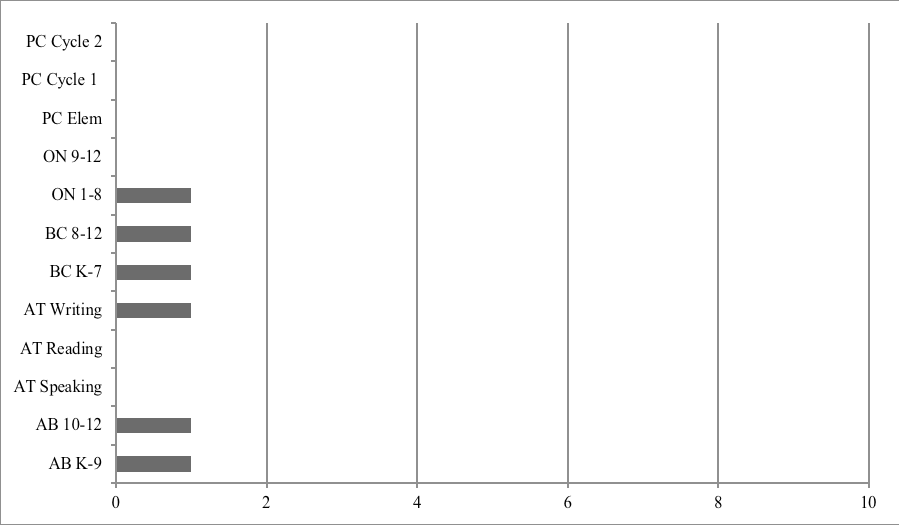
Figure 8. Theme 2d: Using digital resources, media and technology to create knowledge. Frequency of learning outcomes in each provincial curriculum standards document.
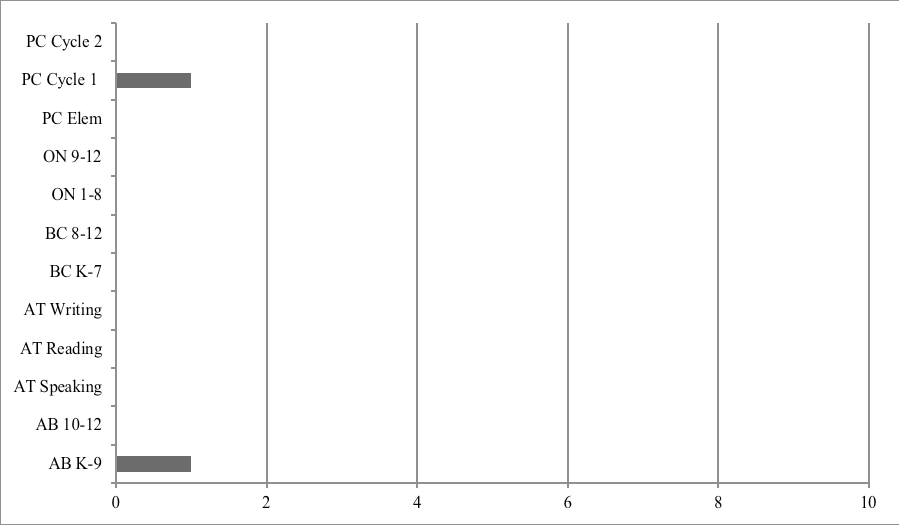
Figure 9. Theme 2e: Using digital resources, media and technology to create solutions. Frequency of learning outcomes in each provincial curriculum standards document.
Figures 3-9 display the disparate coverage of learning outcomes that relate to the student learner as actively processing, thinking, creating and communicating with technology. Theme 1a, “Processing large volumes of information for critical thinking” (Figure 3) is covered well in the learning outcomes for the provinces of Ontario, British Columbia and to some extent in Quebec and Alberta. This is an encouraging finding, however, it is juxtaposed to the low incidence of learning outcomes for Theme 1b, “Processing large volumes of information for communicating” (Figure 4). Theme 1b is noted in all provinces’ learning outcomes, albeit with low frequency counts.
In general, there is scant coverage of learning outcomes that relate to the use of digital resources, media and technology. Theme 2a, “Using digital resources, media and technology to access information” (Figure 5), is infrequently cited by Ontario, Alberta and the Atlantic Provinces. All of the provinces moderately cover Theme 2b, “Using digital resources, media and technology to critically interpret and evaluate ideas” (Figure 6); Ontario is the most dominant in this cluster. Similarly, all of the provinces briefly cover, Theme 2c, “Using digital resources, media and technology to communicate” (Figure 7). The final two themes which relate to the creation of knowledge and solutions, are seldom covered by learning outcomes. Theme 2d, “Using digital resources, media and technology to create knowledge” (Figure 8) is addressed by one learning outcome in Ontario, British Columbia (each of K-7; 8-12) and Alberta (each of K-9; 10-12). Theme 2e, “Using digital resources, media and technology to create solutions” (Figure 9) is addressed by one learning outcome in Quebec and Alberta (K-9). Notable is the distinct absence of learning outcomes related to competencies in the context of core subjects or using social media to communicate and learn. What do we draw from this analysis? Current learning outcomes in the English language arts curriculum standards are reflecting an emphasis on the student learner as a processor of information for critical thinking with less prominence devoted to learning outcomes that encourage the use of digital resources, media and technology access, interpret, communicate and create that information.
DISCUSSION
The article has provided a review of Canadian provincial and territorial curriculum standards documents with respect to 21st century and digital literacy skills and has underscored the need for a significant revision and update of these official standards. The findings of this review highlight the distinct gaps in curricular learning outcomes that should delineate the competencies of the 21st century and digital literacies. We found that there is inconsistent and minimal coverage of the competencies of “Using digital resources, variety of media and technology to access information, create knowledge and create solutions.” These competencies are integral to inquiry-based learning approaches that are in practice in many jurisdictions. Next, there are no provinces that explicitly mention in the curriculum standards that learners should be, “Developing 21st century competencies in the context of core subjects.” It is well established that cross-curricular learning is enhanced by the integration with literacy skills instruction (Cervetti & Pearson, 2012). Finally, the competency of “Using social media to communicate and learn” is absent from all of the provinces’ curriculum documents. This is not surprising given the fact that the publication dates of the documents that range from 2000-2012 and the explosion of social media is a recent reality (Buckingham & Martínez-Rodríguez, 2013).
It is worth noting that many of the provinces have supplementary resources for teachers that provide recommendations for instructional approaches and resources that align with 21st century learning. This is an attempt to fill the gap between standards documents and practice. Examples of these supplementary resources include: Digital Literacy Framework (Profiles and Learning Activities) (British Columbia, n.d.); Journey On (Prince Edward Island Education, 2006); Literacy with ICT Across the Curriculum (Northwest Territories Education, 2012). As well, attempts have been made to include 21st century learning principles in recent provincial and territorial education position statements. Examples of these include: A Vision for 21st Century Education (British Columbia Premier’s Technology Council, 2010); Emerging Technologies in the 21st Century: A Summary of Final Reports (Alberta Education, 2008); Shaping a New Vision for Public Education in Nova Scotia (Nova Scotia School Boards Association, 2014); Towards Defining 21st Century Competencies for Ontario (Ontario Ministry of Education, 2016). However, the curriculum documents are lagging woefully behind practices and position statements. The first province to pick up this gauntlet is British Columbia (2016) who has just recently piloted a revised set of curricula honoring 21st century skills.
The rhetoric about 21st century learning that has been articulated by departments and ministries of education in the Canadian provinces is similar to that of other countries: broad statements and recommendations that attempt to extend and modernize out-of-date standards. In the United States, for example, this has been articulated in a review (Soulé & Warrick, 2015) of over a decade of research that still points to the lack of focus on 21st century skills. This review states that public education needs to align with 21st century learning skills and prepare students with competencies such as creativity, communication, collaboration, and critical thinking. There is a disconnect among the curriculum standards that teachers are referencing, recently espoused instructional approaches and resources, and national policy on 21st century learning. This leaves educators challenged to address the contemporary learning needs of their students by filling in the gaps between curricula and pedagogy. What is needed is Canadian national policy that attends to issues of policy and infrastructure for the support of teachers’ practices and the learning of their students. This is not a novel or recent need.
In 2010, the Media Awareness Network published a white paper with recommendations for media and digital literacy. Particularly pertinent to this current paper is the mandate of the Media Awareness Network to bring awareness to the need for Canadian citizens to possess skills and knowledge to “access, use, understand and create with digital technology” (Media Awareness Network, 2010, p. i). Recall that this competency was inconsistently and minimally addressed in the findings above. Over six years ago, the Media Awareness Network called for a national task force to come together and create an online digital portal and wiki providing professional learning and instructional resources. These resource recommendations (see Media Smarts, n.d.-d), while aimed primarily at digital literacy, are inclusive of 21st century learning skills such as problem solving, and communication and collaboration.
In addition, the Canadians for 21st Century Learning & Innovation (2012) has impressed that it is important to understand the imperative for modernizing our education systems to meet the new realities of the knowledge and digital era. The publications, Shifting minds: A 21st Century Vision of Public Education for Canada (Canadians for 21st Century Learning & Innovation, 2012) and very recently, Shifting Minds 3.0: Redefining the Learning Landscape in Canada (Canadians for 21st Century Learning & Innovation, 2015) continue to articulate six areas that need to shift to drive systemic change: curriculum; pedagogy; learning environment; governance; citizen engagement; assessment. There are specific re-design priorities (Canadians for 21st Century Learning & Innovation, 2012) that echo the findings in this current paper; for example, among the Curriculum re-design priorities are “21st century competencies must be infused throughout all learning outcomes” (p. 14) and “learning outcomes must be rationalized across subject areas to reduce redundancy while strengthening cross-curricular relationships” (p. 14). One of the Pedagogy re-design priorities is “learners must have individualized access to the internet and digital resources” (p. 15). A re-design priority in the learning environment, “mobile learning opportunities should be integrated with other learning delivery models” (p. 15) suggests that educators themselves avail of media and technology to enhance their instructional methods. The Canadians for 21st Century Learning & Innovation (2012) document concludes with a call to action for teachers, principals and policy makers. Common among these actions is for all to advocate for a national learning framework founded on 21st century models of learning. Given that successful educational change, combines top-down and bottom-up strategies (Fullan, 1994), policymakers should “ensure all learning outcomes and assessment models are relevant to the learning needs of students” (p. 12). Principals might think to “embrace social media as a learning tool” and “align teacher training activities to modernizing instructional practices, including the teaching of 21st century competencies and integrating technology with pedagogy” (Fullan, 1994, p. 13). Finally, of the call to action for teachers is to engage in their own professional learning to “promote and attend in-service training opportunities on 21st century learning models, methodologies and digital resources and tools” (Fullan, 1994, p. 13).
Recall the research question: How are the competencies of the 21st century learner reflected in the learning outcomes within the English language arts curriculum standards documents for the Canadian provinces and territories? Our findings suggest the response to this question would be, “to a certain extent.” This response is bolstered by curriculum standards that address processing information and using media and technology for critical thinking and communication. However, it is our position that across Canada, English language arts curricula are not harnessing the full potential of digital media and technology to access information, make cross-disciplinary connections, and create knowledge and solutions. What is happening in some classrooms may be more aligned with the ways in which students are engaged and communicate through social media outside of the classroom; however, there is no definitive policy or method of evaluating these skills of our 21st century learners. There should be a pan-Canadian set of standards to encompass the ideological practices that are part and parcel of technology. As a nation, we are at a point where recommendations and espoused learning pedagogies need to be galvanized into English language arts curriculum standards that are consistent with 21st century and digital literacy learning competencies.
REFERENCES
Action Canada Task Force. (2013). Future tense: Adapting Canadian education systems for the 21st century. Retrieved from http://www.actioncanada.ca/project/future-tense-adapting-canadian-education-systems-21st-century/
Alberta Education. (2008). Emerging technologies in the 21st century: A summary of final reports. Retrieved from https://archive.org/details/emergingtechnolo00albe
Alberta Learning. (2000). English language arts (K-9). Retrieved from https://education.alberta.ca/media/450519/elak-9.pdf
Alberta Learning. (2003). English language arts (senior high). Retrieved from https://education.alberta.ca/media/160418/ela-pos-10-12.pdf
British Columbia. (n.d.). Digital literacy framework (profile and learning activities). Retrieved from http://www2.gov.bc.ca/gov/content/education-training/k-12/teach/teaching-tools/digital-literacy
British Columbia. (2006). English language arts kindergarten to grade 7: Integrated resource package 2006. Retrieved from http://www.bced.gov.bc.ca/irp//pdfs/english_language_arts/2006ela_k7.pdf
British Columbia. (2007). English language arts 8 to 12. Available from https://www2.gov.bc.ca/gov/content/education-training/k-12/teach/curriculum/english/english-language-arts/english-language-arts-8-to-12-2007
British Columbia, (2016). BC’s new curriculum. Retrieved from https://curriculum.gov.bc.ca/curriculum-updates
British Columbia Premier’s Technology Council, (2010). A vision for 21st century education. Retrieved from https://premierstechnologycouncil.ca/wp-content/uploads/2016/11/PTC-Special-Report-A-Vision-for-21st-Century-Education.pdf
Bowen, G. A. (2009). Document analysis as a qualitative research method. Qualitative Research Journal, 9(2), 27-40.
Buckingham, D., & Martínez-Rodríguez, U. (2013). Interactive youth: New citizenship between social networks and school settings. Comunicar, 20(40), 10-13.
Burnett, C., & Merchant, G. (2015). The challenge of 21st-century literacies. Journal of Adolescent & Adult Literacy, 59(3), 271-274.
Canadians for 21st Century Learning & Innovation. (n.d.). C21 Research. Retrieved from http://c21canada.org/c21-research/
Canadians for 21st Century Learning & Innovation. (2012). Shifting minds: A 21st century vision of public education for Canada. Retrieved from http://www.c21canada.org/wp-content/uploads/2012/11/Shifting-Minds-Revised.pdf
Canadians for 21st Century Learning & Innovation. (2014). Shifting minds index: An assessment metric for 21st century learning. Retrieved from http://www.c21canada.org/wp-content/uploads/2015/04/Shifting-Minds-LEARNING-INDEX-Sept-29.pdf
Canadians for 21st Century Learning & Innovation. (2015). Shifting minds 3.0: Redefining the learning landscape in Canada. Retrieved from http://www.c21canada.org/wp-content/uploads/2015/05/C21-ShiftingMinds-3.pdf
Cervetti, G., & Pearson, P. (2012). Reading, writing, and thinking like a scientist. Journal of Adolescent & Adult Literacy, 55 (7), 580-586.
Council of Ministers of Education, Canada (CMEC). (2013a). Ministers of education highlight 21st-century literacies on international literacy day. Retrieved from http://www.cmec.ca/278/Press-Releases/Ministers-of-Education-Highlight-21st-Century-Literacies-on-International-Literacy-Day.html?id_article=641
Council of Ministers of Education, Canada (CMEC). (2013b). Measuring up: Canadian results of the OECD PISA study. Retrieved from http://cmec.ca/Publications/Lists/Publications/Attachments/318/PISA2012_CanadianReport_EN_Web.pdf
English Language Arts. (n.d.). Retrieved from http://www.education.gouv.qc.ca/fileadmin/site_web/documents/PFEQ/educprg2001-051.pdf
Fullan, M. (1994). Coordinating top-down and bottom-up strategies for educational reform. Systemic reform: Perspectives on personalizing education. Retrieved from http://michaelfullan.ca/wp-content/uploads/2016/06/13396035630.pdf
Government of Canada (2015). Education in Canada. Retrieved from http://www.cic.gc.ca/english/newcomers/after-education.asp
Guba, E., & Lincoln, Y. (1982). Epistemological and methodological bases of naturalistic inquiry. Educational Technology Research and Development, 30(4), 233-252.
Halverson, E. R., & Sheridan, K. M. (2014). The maker movement in education. Harvard Educational Review, 84(4), 495-504.
Hoechsmann, M., & DeWaard, H. (2015). Mapping digital literacy policy and practice in the Canadian education landscape: MediaSmarts. Retrieved from http://mediasmarts.ca/sites/mediasmarts/files/publication-report/full/mapping-digital-literacy.pdf
Jenkins, H. (2006). Convergence culture: Where old and new media collide. New York, NY: New York University Press.
Mayring, P. (2000). Qualitative content analysis. Forum: Qualitative social research, 1(2). Retrieved from http://www.qualitative-research.net/index.php/fqs/article/view/1089/2385
McLuhan, M. (1964). The medium is the message. In M. McLuhan (Ed.), Understanding media: The extensions of man (pp. 1-18). New York, NY: McGraw-Hill.
Media Awareness Network (2010). Digital literacy in Canada: From inclusion to transformation. Retrieved from http://mediasmarts.ca/sites/mediasmarts/files/pdfs/publication-report/full/digitalliteracypaper.pdf
Media Smarts (n.d.-a). Atlantic Provinces: English Language Arts K-6 Overview. Retrieved from http://mediasmarts.ca/teacher-resources/digital-media-literacy-outcomes-province-territory/atlantic-provinces/atlantic-provinces-english-language-arts-k-6-overview
Media Smarts (n.d.-b). English Language Arts 7-9 Overview. Retrieved from http://mediasmarts.ca/teacher-resources/digital-media-literacy-outcomes-province-territory/atlantic-provinces/english-language-arts-7-9-overview
Media Smarts (n.d.-c). English Language Arts 10-12 Overview. Retrieved from http://mediasmarts.ca/teacher-resources/digital-media-literacy-outcomes-province-territory/atlantic-provinces/english-language-arts-10-12-overview
Media Smarts. (n.d.-d). Teacher resources. Retrieved from http://mediasmarts.ca/teacher-resources
National Council of Teachers of English. (2013). The NCTE definition of 21st century literacies. Retrieved from http://www.ncte.org/positions/statements/21stcentdefinition
Northwest Territories Education. (2012). Literacy with ICT across the curriculum. Retrieved from https://www.ece.gov.nt.ca/sites/www.ece.gov.nt.ca/files/resources/lwict_infusion_guide_-_2012.pdf
Nova Scotia School Boards Association. (2014). Shaping a new vision for public education in Nova Scotia. Retrieved from http://www.nssba.ca/component/docman/doc_download/252-nssba-discussion-paper
Ontario Ministry of Education. (2006). Language (Grades 1-8). Retrieved from http://www.edu.gov.on.ca/eng/curriculum/elementary/language18currb.pdf
Ontario Ministry of Education. (2007). English (Grades 9-10). Retrieved from http://www.edu.gov.on.ca/eng/curriculum/secondary/english910currb.pdf
Ontario Ministry of Education. (2007). English (Grades 11-12). Retrieved from http://www.edu.gov.on.ca/eng/curriculum/secondary/english1112currb.pdf
Ontario Ministry of Education. (2016). Towards defining 21st century competencies for Ontario. Retrieved from http://www.edugains.ca/resources21CL/About21stCentury/21CL_21stCenturyCompetencies.pdf
Organisation for Economic Co-operation and Development (OECD). (2009). Education today: The OECD perspective. Available from http://www.oecdbookshop.org/browse.asp?pid=title-detail&lang=en&ds=&ISB=962009021E1
Organisation for Economic Co-operation and Development (OECD). (2013). PISA 2012 Assessment and analytical framework: Mathematics, reading, science, problem solving and financial literacy. Paris, France: OECD. Retrieved from http://www.oecd.org/pisa/pisaproducts/PISA%202012%20framework%20e-book_final.pdf
Peppler, K. A., & Bender, S. (2013). Maker movement spreads innovation one project at a time. Phi Delta Kappan, 95(3), 22-27.
Postman, N. (1993). Technopoly: The surrender of culture to technology. New York, NY: Vintage.
Prince Edward Island Education. (2006). Journey on. Retrieved from https://www.princeedwardisland.ca/sites/default/files/publications/eelc_comm_it_2.pdf
Schleicher, A. (2015). Schools for 21st-century learners: Strong leaders, confident teachers, innovative approaches, international summit on the teaching profession. Retrieved from http://dx.doi.org/10.1787/9789264231191-en
Quebec Education Program (QEP). (n.d.-a). Secondary English language arts [cycle 1]. Retrieved from http://www.education.gouv.qc.ca/fileadmin/site_web/documents/PFEQ/chapter51.pdf
Quebec Education Program (QEP). (n.d.-b). Secondary English language arts [cycle 2]. Retrieved from http://www.education.gouv.qc.ca/fileadmin/site_web/documents/PFEQ/5b_QEP_SELA.pdf
Soulé, H., & Warrick, T. (2015). Defining 21st century readiness for all students: What we know and how to get there. Psychology of Aesthetics, Creativity, and the Arts, 9(2), 178-186.
Street, B. V. (1984). Literacy in theory and practice. New York, NY: Cambridge University Press.
Weber, R. P. (1990). Basic content analysis. (2nd ed.). London, United Kingdom: Sage.
Williams, R. (1990). Culture and society: Coleridge to Orwell. London, United Kingdom: The Hogarth Press. (Original work published in 1958)
APPENDIX A
Overview of seven competencies of 21st century learners (Canadians for 21st Century Learning & Innovation, 2012, pp. 10-12))
- 1. Creativity, Innovation and Entrepreneurship
• Creativity: The ability to apply creative thought processes to create something of value.
• Innovation and Entrepreneurship: The capacity to create and apply new knowledge in innovative and entrepreneurial ways to create new products or solve complex problems.
- 2. Critical Thinking
• A deep understanding of and capacity to apply the elements and processes associated with critical thinking and problem solving.
• The ability to acquire, process, interpret, rationalize and critically analyze large volumes of often conflicting information to the point of making an informed decision and taking action in a timely fashion.
- 3. Collaboration
• The ability to interact positively and respectfully with others in creating new ideas and developing products.
• The ability to lead or work in a team and to relate to other people in varying contexts, including capacity to resolve and manage conflict.
• The capacity for sensitivity to the issues and processes associated with collaborating across cultures.
• The ability to collaborate across networks, using various information and communication technologies.
- 4. Communication
• High level literacy skills, including strength in a person’s mother tongue with multilingual capacity a definite asset.
• The ability to use technology to develop 21st Century competencies in the context of core subjects.
• The capacity to communicate using a variety of media and technologies.
• The ability to access, analyze, integrate and manage large volumes of information.
• The capacity to effectively use social media to communicate and resolve challenges.
• The ability to critically interpret and evaluate ideas presented through a variety of media and technologies.
• Highly developed cooperative interpersonal capabilities.
- 5. Character
• Life-long learner
• Leadership, responsibility and accountability
• Self-directed, adaptable and resilient
• Tolerant, ethical and fair
• Personal productivity
• Interpersonal (people) skills
• Mental and physical well being
• Proficiency in managing personal
• Relationships
- 6. Culture and Ethical Citizenship
• The capacity to comprehend Canada’s political, social, economic and financial systems in a global context.
• The ability to appreciate cultural and societal diversity at the local, national and global levels.
• The ability to critically analyze the past and present and apply those understandings in planning for the future.
• The capacity to understand key ideas and concepts related to democracy, social justice and human rights.
• Disposition and skills necessary for effective civic engagement.
• The ability to understand the dynamic interactions of Earth’s systems, the dependence of our social and economic systems on these natural systems, our fundamental connection to all living things, and the impact of humans upon the environment.
• The capacity to consider the impact of societal and environmental trends and issues.
- 7. Computer and Digital Technologies
• The capacity to use computers and digital resources to access information and create knowledge, solutions, products and services.
• The capacity to use social media for learning.
APPENDIX B
|
Province(s) |
Policy Document |
Description |
URL |
|
Alberta (Used by NWT) |
English Language Arts, K-9 (2000)
English Language Arts, Senior High (2003) |
Both curricula include 5 General Outcomes that provide guidelines for the knowledge, skills and attitudes that students possess as they engage in listening, speaking, reading, writing, viewing, and representing. |
https://education.alberta.ca/media/450519/elak-9.pdf
|
|
Atlantic Canada Provinces (Nova Scotia, New Brunswick, P.E.I., Newfoundland & Labrador) |
Atlantic Provinces Education Foundation Framework for English Language Arts (2012) |
There are 3 broad outcomes (Speaking and Listening; Reading and Viewing; Writing and Other Ways of Representing) and within these broad outcomes are 10 general outcomes. Outcomes advance as students progress through checkpoints at the end of Grades 3, 6, 9, and 12. |
Original document (1996) http ://lia.ednet.ns.ca/pdfs/foundations-ela.pdf
Updated documents (2012) http://mediasmarts.ca/teacher-resources/media-education-outcomes-province/atlantic-provinces |
|
British Columbia* (used by Yukon)
|
English Language Arts Kindergarten to Grade 7 (2006) English Language Arts 8 to 12 (2007) |
Both curricula are organized by Oral Language (Speaking and Listening), Reading and Viewing, and Writing and Representing. Within each of these, the Prescribed Learning Outcomes are recursive and cumulative from K-7 and 8-12. |
http://www.bced.gov.bc.ca/irp//pdfs/english_language_arts/2006ela_k7.pdf |
|
Ontario |
Language (Grades 1-8)(2006)
English (Grades 9-10 and 11-12)(2007) |
Both curricula have four strands: Oral Communication (OC), Reading ®, Writing (W), Media Literacy (ML). Within each strand there are Overall Learning Expectations and Specific Learning Expectations. (NOTE: For this paper, a review was done for Grade 8 Learning Expectations (1-8 cumulative) and English Grade 10 (academic) and 12 (university preparation) (courses are tiered). |
http://www.edu.gov.on.ca/eng/curriculum/elementary/language18currb.pdf
http://www.edu.gov.on.ca/eng/curriculum/secondary/english910currb.pdf
http://www.edu.gov.on.ca/eng/curriculum/secondary/english1112currb.pdf |
|
Quebec |
English Language Arts (n.d.)
Secondary English Language Arts [cycle 1] (QEP, n.d.-a)
Secondary English Language Arts [cycle 2] (QEP, n.d.-b) |
English Language Arts (n.d.-a) has 4 broad Competencies and within each of these there are 5 Key Features that indicate learning outcomes and appendix, “Suggestions for Using Information and Communications Technologies (ICT)” (p. 108). Secondary English Language Arts [cycle 1] (n.d.-a) has 4 broad Competencies and within each of these there are 3 Key Features that indicate learning outcomes. Secondary English Language Arts [cycle 2] (n.d.-b) has 3 broad Competencies and within each of these there are 3 Key Features that indicate learning outcomes. |
http://www.education.gouv.qc.ca/fileadmin/site_web/documents/PFEQ/educprg2001-051.pdf
http://www.education.gouv.qc.ca/fileadmin/site_web/documents/PFEQ/chapter51.pdf
http://www.education.gouv.qc.ca/fileadmin/site_web/documents/PFEQ/5b_QEP_SELA.pdf |
NOTE. *At the time of this publication, British Columbia is rolling out new curricula in all subjects (https://curriculum.gov.bc.ca/curriculum-updates).